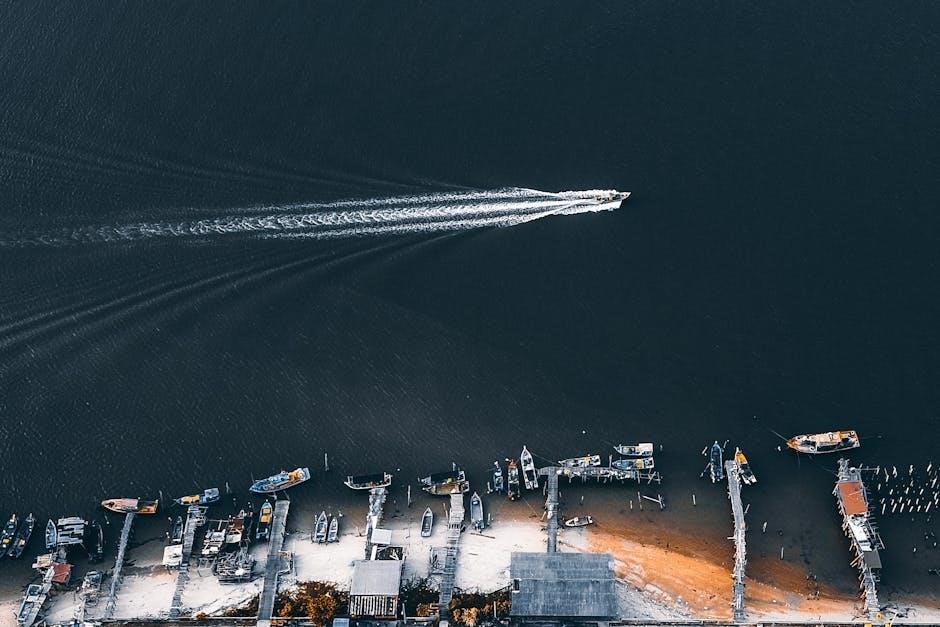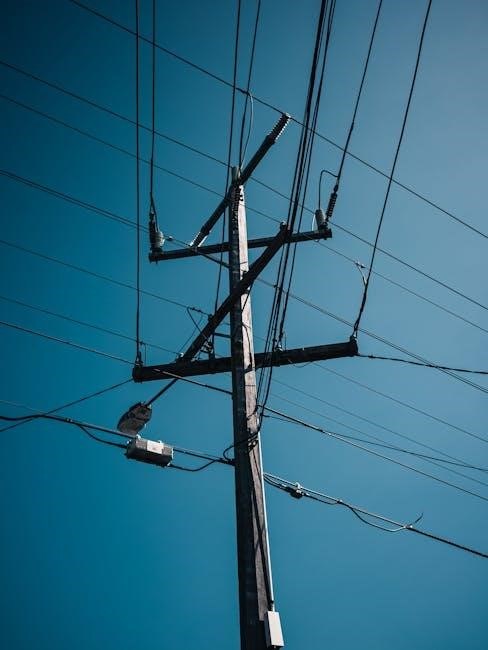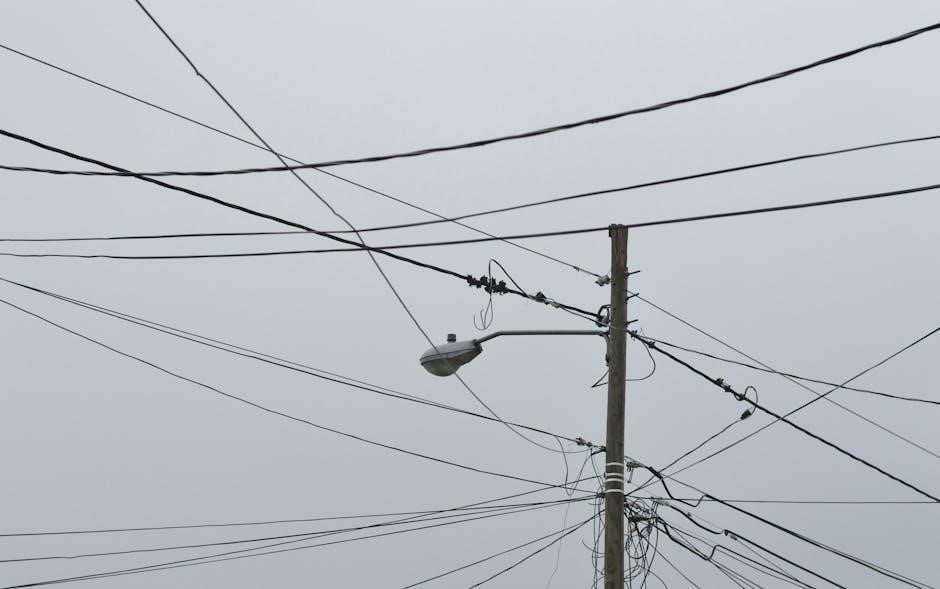manual power pole for boats
- Published
- in Manuals
A manual power pole is a shallow water anchoring system designed for boats, enabling silent and precise anchorage in shallow waters. Ideal for anglers and small boat owners, it offers a stealthy, portable, and cost-effective solution for securing vessels without motorized noise, making it perfect for fishing and navigating calm waters quietly.
1.1 What is a Manual Power Pole?
A manual power pole for boats is a non-motorized anchoring system designed for use in shallow waters. It is operated manually, typically by pushing a pole into the seabed to secure the boat in place. Unlike motorized versions, it relies on human effort for deployment and retrieval, making it a quieter and more environmentally friendly option. The manual power pole is popular among fishermen and small boat enthusiasts as it provides a cost-effective, portable, and reliable means of anchoring without the noise that might scare away fish. Its simplicity and lack of complex mechanisms make it easier to maintain compared to motorized systems.
1.2 Importance of Shallow Water Anchoring Systems
Shallow water anchoring systems, like manual power poles, are essential for boats operating in coastal areas, flats, and shallow bodies of water. These systems provide stability and precision, allowing anglers to position their boats quietly and effectively without disturbing fish. The ability to anchor in shallow waters is critical for fishing success, as it enables boats to remain steady in areas where traditional anchors may fail. Additionally, shallow water anchoring systems prevent boat drift, reducing the risk of damage to marine ecosystems. They are particularly valuable for small boats and flats boats, offering a reliable and efficient way to secure the vessel in environments where motorized systems might be impractical or disruptive. This capability enhances both fishing experiences and safety in shallow water conditions.

Benefits of Using a Manual Power Pole
Manual power poles offer silent operation, portability, and ease of use, making them ideal for shallow water fishing and small boats. They provide cost-effective anchoring solutions.
2.1 Noise Reduction for Stealthy Fishing
Manual power poles are highly valued for their ability to reduce noise, making them ideal for stealthy fishing. Unlike motorized anchors, manual systems operate without the noise of engines or electric motors, allowing anglers to approach fish undetected. This quiet operation is crucial in shallow waters where fish are often spooked by even slight disturbances. By minimizing noise, manual power poles enhance the overall fishing experience, giving anglers a better chance of reeling in their catch. The absence of mechanical sounds ensures a more natural environment, making it easier to sneak up on wary fish. This feature is particularly beneficial in shallow, calm waters where silence is key to successful fishing trips.
2.2 Portability and Ease of Use
Manual power poles are renowned for their portability and ease of use, making them a practical choice for anglers and small boat owners. Their lightweight design allows for easy transportation and installation, even on smaller vessels like kayaks or flats boats. Unlike motorized systems, manual power poles require no complex setup or heavy machinery, ensuring a hassle-free experience. Users can quickly deploy and retrieve the pole, making it ideal for spontaneous anchoring in shallow waters. The simplicity of manual operation also eliminates the need for technical expertise, allowing anyone to master its use. This portability and ease of use make manual power poles a versatile and convenient option for a variety of fishing and boating scenarios, enhancing the overall boating experience without compromising on functionality.
2.3 Cost-Effective Alternative to Motorized Anchors
Manual power poles offer a budget-friendly solution for boaters seeking reliable anchoring systems without the high costs of motorized alternatives. Unlike electric or hydraulic anchors, manual power poles require no expensive components or energy sources, significantly reducing initial and maintenance expenses. Their simple, durable design minimizes the need for repairs or replacements, further lowering long-term costs. This affordability makes manual power poles accessible to a wider range of boaters, including those with smaller vessels or limited budgets. While motorized systems may offer convenience, manual options provide a practical and economical choice for shallow water anchoring needs, delivering excellent value without compromising on performance or reliability. This cost-effectiveness is a key factor in their popularity among anglers and recreational boaters seeking efficient, affordable solutions. Their low cost ensures that boaters can enjoy the benefits of secure anchoring without financial strain, making them an ideal choice for many users.

Design and Construction of Manual Power Poles
Manual power poles are crafted for durability and portability, featuring a telescoping design with rust-resistant coatings to withstand marine environments and ensure reliable performance in shallow waters.
3.1 Materials Used in Manufacturing
Manual power poles are typically constructed from durable, marine-grade materials such as aluminum, stainless steel, and fiberglass. Aluminum is a popular choice due to its lightweight yet robust properties, making it ideal for shallow water anchoring systems. Stainless steel components are often used for hardware and fasteners to ensure resistance to corrosion and longevity in saltwater environments. Fiberglass is another common material, offering flexibility and resistance to environmental stress. The poles are usually coated with protective layers to withstand harsh marine conditions, ensuring reliability and extending their lifespan. The selection of these materials ensures that manual power poles are both sturdy and lightweight, making them easy to deploy and retrieve while maintaining their structural integrity over time.

3.2 Key Components of a Manual Power Pole
A manual power pole consists of several essential components designed to ensure effective anchoring in shallow waters. The primary pole is typically made of durable materials such as aluminum or fiberglass, providing strength and flexibility. The anchor point, often a sharpened tip or a specialized foot, ensures secure contact with the seafloor. A spring or hinge mechanism allows the pole to absorb movement without dislodging, while a manual deployment system enables users to lower and raise the pole effortlessly. Additional components include a mounting bracket for secure attachment to the boat, a tether or rope for stabilizing the vessel, and optional accessories like adjustable handles for ease of use. These components work together to provide a reliable, quiet, and efficient anchoring solution for boats in shallow water environments.

Installation and Setup
Installing a manual power pole involves mounting the bracket securely on the boat, adjusting the pole length, and ensuring proper alignment for stable anchoring in shallow waters.
4.1 Step-by-Step Installation Guide
Installing a manual power pole begins with preparing the boat and tools. Locate the mounting location on the boat’s transom or bow, ensuring it’s sturdy and level. Attach the mounting bracket using screws or bolts, tightening securely. Next, adjust the pole’s length to fit the water depth and align it properly for even anchoring. Drill holes if necessary and install any additional hardware provided. Finally, test the system in shallow water to ensure stability and make adjustments as needed. Always follow the manufacturer’s instructions and consider professional help if unsure. Proper installation ensures safe and effective use of the power pole during fishing or anchoring.
4.2 DIY vs. Professional Installation
Deciding between DIY and professional installation for a manual power pole depends on your skill level and confidence. DIY installation can save money and is feasible for those with basic tools and mechanical aptitude. It requires careful planning, precise measurements, and adherence to the manufacturer’s instructions. However, if you lack experience or encounter complex setups, professional installation is recommended. Professionals ensure proper alignment, secure mounting, and optimal functionality, reducing the risk of errors. They also offer warranties and liability coverage, providing peace of mind. While DIY is cost-effective, professional installation guarantees reliability and safety, especially for high-value boats or unfamiliar installations; Weigh your expertise and time against the cost of professional services to make the best choice for your vessel.

Operation and Functionality
A manual power pole operates by silently deploying into shallow waters, securing the boat with minimal disturbance. Its functionality includes easy deployment, anchoring, and retrieval, ensuring effective boat stabilization in calm conditions.
5.1 Deploying the Power Pole Manually
Deploying a manual power pole involves lowering the pole into the water and pushing it into the seabed. Typically, the pole is 5 to 6 feet long and made of durable, rust-resistant materials. To deploy, anglers position their boat in shallow water, extend the pole, and manually push it into the sediment. The process requires minimal effort and ensures quiet operation, crucial for not startling fish. Proper technique involves ensuring the pole is fully seated to maintain stability. In challenging conditions, such as hard bottoms or dense vegetation, anglers may need to wiggle the pole or use additional tools to secure it. Once deployed, the boat is tethered to the pole, providing a stationary platform for fishing or resting. This method is particularly effective in calm, shallow waters where traditional anchors might fail. Regular practice enhances the efficiency of deployment and retrieval.

5.2 Anchoring Techniques in Shallow Waters
Manual power poles are ideal for anchoring in shallow waters, typically between 1 to 6 feet deep. The pole is pushed into the seabed, securing the boat without disturbing the surrounding environment. Anglers often position their boat at an angle to maximize stability. The key is to ensure the pole is fully seated in the sediment for a firm hold. In soft bottoms, anglers may twist the pole slightly to enhance grip, while in harder surfaces, gentle rocking motions can help secure it. Once anchored, the boat remains stationary, allowing for precise fishing or resting. This method is particularly effective in flats, bay boats, or small skiffs, where traditional anchors might not hold or could damage the seabed. The manual process ensures quiet operation, minimizing the risk of startling fish, making it a preferred choice for anglers seeking stealth and control in shallow waters.
5.3 Retrieving the Power Pole After Use
Retrieving a manual power pole after use requires careful attention to ensure the process is smooth and damage-free. Start by loosening the tension on the tether or rope attached to the boat. Gently twist and pull the pole upward, working it free from the sediment. If the pole is stuck, avoid yanking forcefully, as this could bend or break the unit. Instead, rock it back and forth while pulling to dislodge it from the seabed. Once retrieved, inspect the pole for any debris or damage. Rinse it with fresh water to remove dirt and prevent corrosion. Store the pole securely in its mount or bracket to avoid movement during travel. Proper retrieval ensures the longevity of the power pole and maintains its effectiveness for future use.

Safety and Maintenance Tips
Always handle the manual power pole with care to avoid accidents. Regularly clean and inspect for damage or corrosion. Lubricate moving parts and store properly to ensure longevity and reliability.
6.1 Safety Precautions When Using a Manual Power Pole
When using a manual power pole, it’s crucial to follow safety guidelines to avoid accidents. Always wear protective gloves and eyewear to prevent injury from sharp edges or sudden movements. Ensure the area around the power pole is clear of obstructions and passengers before deployment or retrieval. Avoid overloading the pole, as this can cause structural damage or instability. Properly secure the boat to the pole using recommended tethering techniques to maintain control. Be mindful of underwater obstacles like rocks or reefs that could impair the pole’s functionality. Regularly inspect the pole for signs of wear or corrosion and address issues promptly. Never operate the power pole in deep water or rough conditions, as it is designed for shallow, calm environments. By adhering to these precautions, you can ensure safe and effective use of your manual power pole.
6.2 Regular Maintenance to Ensure Longevity
Regular maintenance is essential to extend the lifespan of a manual power pole. Start by thoroughly cleaning the pole and its components after each use to remove dirt, sand, or corrosion-inducing substances. Lubricate moving parts periodically to ensure smooth operation and prevent rust. Inspect the pole for dents, cracks, or wear, addressing any damage promptly to avoid further deterioration. Apply a rust-inhibiting coating to metal parts, especially in saltwater environments. Store the pole in a dry, protected area when not in use to prevent environmental damage. Regularly check and replace worn-out accessories like springs or screws. Following the manufacturer’s maintenance schedule and guidelines is crucial for optimal performance and durability. By maintaining your manual power pole, you ensure it remains reliable and functional for years of trouble-free anchoring in shallow waters.

Troubleshooting Common Issues
Common issues with manual power poles include sticking or jamming due to debris or corrosion. Regular cleaning and lubrication can resolve these problems. Inspect for damage and apply rust-inhibiting coatings to prevent future issues.
7.1 Solving Stuck or Jammed Power Poles
When a manual power pole becomes stuck or jammed, it is often due to debris, sediment, or corrosion. To resolve this, first inspect the pole and surrounding area for any obstructions. Gently clean away dirt or marine growth using a soft brush or cloth. If the pole remains stuck, apply a marine-grade lubricant to reduce friction. In severe cases, carefully wiggle the pole back and forth while applying upward pressure. Avoid using forceful tools that could damage the mechanism. For corrosion-related issues, apply a rust-inhibiting coating after cleaning. Regular maintenance, such as lubricating moving parts and inspecting for wear, can prevent jams from occurring. Always prioritize gentle handling to avoid further damage to the power pole or its components.
7.2 Addressing Corrosion or Damage
Corrosion and damage to a manual power pole can compromise its functionality and longevity. To address these issues, start by inspecting the pole for signs of rust, dents, or scratches. For minor corrosion, use a wire brush to remove rust and apply a marine-grade rust inhibitor or protective coating. More extensive damage may require disassembling the pole to replace worn or corroded parts. Regularly cleaning the pole and storing it in a dry environment can prevent future corrosion. Applying a protective wax or sealant to metal surfaces also helps shield against moisture. For significant damage, consult the manufacturer or a professional for repairs. Addressing these issues promptly ensures the power pole remains reliable and performs optimally in shallow water conditions. Regular maintenance is key to extending the life of your manual power pole.

Market and Availability
Manual power poles are widely available in marine stores and online retailers, with popular brands like Power-Pole offering high-quality models. Prices range from $500 to $2,000, depending on features and length.
8.1 Popular Brands and Models
Several reputable brands specialize in manual power poles, with Power-Pole being one of the most recognized names in the industry. Known for their reliability and durability, Power-Pole offers models like the Power-Pole Shallow Water Anchor, which is widely used by anglers and small boat owners. Another notable brand is Royz, which provides affordable and efficient manual anchoring solutions. The Royz Shallow Water Anchor is particularly popular for its ease of use and portability. Additionally, brands like Micro Power-Pole cater to smaller vessels, offering compact designs that are ideal for kayaks or canoes. These brands are trusted for their high-quality materials and innovative designs, making them top choices for boaters seeking manual anchoring systems.
8.2 Where to Buy and Price Ranges
Manual power poles for boats are widely available through various retailers, both online and in-store. Popular options include marine supply stores, online marketplaces like Amazon and eBay, and direct purchases from manufacturers. Many brands, such as Power-Pole and Royz, offer their products through official websites, ensuring authenticity and warranty coverage. Prices vary depending on the model and features, with basic manual power poles starting around $200-$400. Mid-range models with additional features, such as adjustable lengths or durable materials, typically cost between $400-$700. High-end or premium models, designed for heavy-duty use, can range from $700-$1,200. Installation costs may add to the total price, but many users opt for DIY setups to save money. Accessories, like mounting hardware or replacement parts, are also available separately.
A manual power pole is an excellent choice for anglers and small boat owners, offering silent operation, portability, and cost-effectiveness in shallow water environments, enhancing fishing experiences significantly.
9.1 Summary of Key Points
A manual power pole is a shallow water anchoring system designed for boats, offering silent operation, portability, and cost-effectiveness. It is ideal for anglers and small boat owners, providing precise control in shallow waters. The system enhances fishing experiences by reducing noise, allowing stealthy approaches to fish. Its simplicity and ease of use make it a practical alternative to motorized anchors. Suitable for flats boats, skiffs, and other small watercraft, manual power poles are durable and require minimal maintenance. They are environmentally friendly, causing no disturbance to marine life. With key components like sturdy materials and deployable arms, these poles ensure secure anchorage. Overall, manual power poles are a versatile and efficient solution for shallow water navigation and fishing, offering excellent value for their performance and reliability;
9.2 Final Thoughts on Manual Power Poles
Manual power poles represent a practical and efficient solution for shallow water anchoring, offering unparalleled benefits for anglers and boat enthusiasts. Their ability to provide silent operation, portability, and cost-effectiveness makes them an excellent choice for small watercraft. By eliminating the noise associated with motorized systems, they enhance fishing experiences and allow for stealthy navigation. Durable construction and minimal maintenance requirements further add to their appeal. Whether for flats boats, skiffs, or kayaks, manual power poles deliver reliable performance in shallow waters. Their environmental friendliness and ease of use make them a standout option for those seeking to explore serene waterways without disturbing marine life. For anyone looking to elevate their boating or fishing adventures, a manual power pole is a wise and worthwhile investment.
